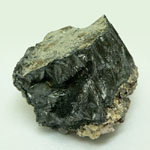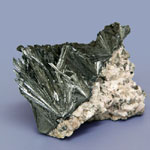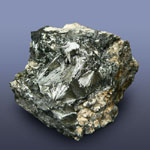Stone, minerals and semiprecious of the world stone
Oxide and hydrooxide: Polianite, pirolusite -->rus
 Diagnostic cart.
Diagnostic cart.
Mn O2 (oxide manganese)
Crystal structure tetragonal
Hardness on the Mohs scale 6-6,5
Specific unit weight mass 4,7-5,1
Cleavage non-existent
Fracture, break padman
Colors darkly-grey, black
Colors in powder triturate black
Glance (glitter, glare) semimetallic

It black powdery mineral. It is more frequent than all associated with other minerals of manganese, mainly noncrystalline. Such association got the name of wad. It is possible to meet Polianite, pirolusite as earthy the masses, fibred aggregates, concretionary concretion. Very rarely it is prismatic black crystals; in this case it is named polianite.
Name from Greek, руr is a fire and ioysis - washing. Together with psilomelan Polianite, pirolusite is main manganese ore. Used for the production of chlorine, on glass business (for discolouring) and smelting of the special sorts of steel.
Rarely be found as idioblasts is a variety polianite (hardness 6,5; brilliance is metallic), pseudomorphosis on manganite (a blackish mineral consisting of basic manganese oxide in monoclinic crystalline form: a source of manganese. Formula: MnO(OH)). Polianite, pirolusite forms radiantly-crystalline the masses, hard or earthily-friable; easily soiled, as rules. Cleavage in two directions; closeness about 5; hardness of nondescript, crumbles easily; a color is grey to black.
Chemical composition (chemistry, compound). Manganese (Mn) 63,2%, oxygen (О) 36,8%. Form of crystalline excretions. Crystals are rare, only in emptinesses it is possible to meet needle-shaped or columnar, basaltiform forms; mainly mineral forms dense thinly (crypto) crystalline, earthy (loose) the masses. Crystalline structure. Grate of type of lattice of rutile. Class of symmetry. Ditetragonal-bipyramidal - 4/mmm. Aggregates. Dense, kidney-shaped reniform and stalactitic-like formations, tumours, radiant and fibred joint, junction.



Diagnostic indication.
An earthy variety gives the very personal touch of black. At heating mineral becomes hard.
Origin provenance genesis.
Has sedimentary genesis. Appeared as chemical sediment in ancient lakes, bogs, lagoons in the conditions of weak circulation of water, but at large maintenance of oxygen. Can exist also as second mineral, appearing at oxidization of minerals of manganese.
Deposit minefield mine and use.
Found out the large mine deposits of dense wad and pyrolusite in Georgia (Transcaucasia, CIS), Dean (India), state of Minas-Zherays (Brazil) and Republic of South Africa. Polianite, pirolusite is important ore on a manganese.
Polianite, pirolusite and his varieties (Psilomelan, wad and other) is very alike on composition, but a type and properties have different. They appeared in the area of weathering ("gossan") from manganiferous mine minerals - rhodonite, rhodochrosite, siderite, will break a secret, (Vestfaliya, Tyuringiya is in Germany). The sedimentary origin of the deposits of manganese ores most known presently is typical: Nikopolskoe (Ukraine, CIS) and Chiaturskoe (Georgia, Transcaucasia CIS). Sometimes mineral appeared because of lixiviating and oxidization.
DOPOG #5.1 
Matters substances, which oxidize
Risk of stormy reaction, self-ignition or explosion at a contact with combustible or flammable matters
To shut out formation of mixture of load with flammable or combustible matters (for example by sawdusts)
Yellow rhombus, number of DOPOG, black flame above by a circle
DOPOG #4.2 
Matters substances, apt at spontaneous combustion
Risk of fire as a result of spontaneous combustion in case if packing is damaged or the source of maintenance happened.
Can stormily react with water
White overhead half of rhombus, red - lower, isometric, number of DOPOG, black flame
DOPOG #4.1 
Flammable hard solid substance matters, self-reactive matters and solid desensitized explosives
Risk of fire. Flammable or combustible matters can catch a fire from sparks or flame. Can contain self-reactive matters, apt at exothermic decomposition in the case of heating, contact with other matters (such as: acids, connections of heavy metals or amines), to the friction or blow.
It can result in the selection of harmful or flammable gases or pair or spontaneous combustion. Capacities can burst at heating (dangerous, perilous - does not burn practically).
Risk of explosion of the desensitized explosives after the loss of desensitizer
Seven vertical red striaes on a white background, isometric, number of DOPOG, black flame
DOPOG #8 
Corrosive (caustic, pungent, acrid) substances matters
Risk of burns as a result of eating away of derma. Can stormily react between itself (components), with water and other matters. Matter, that spilled / scattered, can select a corrosive pair.
Make a danger for a water environment or sewage system
White overhead half of rhombus, black - lower, isometric, number of DOPOG, test tubes, hands
DOPOG #9 
Other hazardous substances matters and produce
Risk of burns. Risk of fire. Risk of explosion.
Make a danger for a water environment or sewage system
Seven vertical black striaes on a white background is a top, white - lower half of rhombus, number of DOPOG
DOPOG #4.3 

Matters substances, which select flammable gases at a contact with water
Risk of fire and explosion at a contact with water.
Gruz, which had scattered, it is necessary to cover and hold dry
Sine-blue rhombus, number of DOPOG, black or white flame
